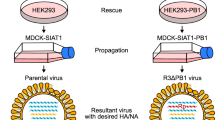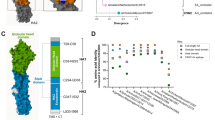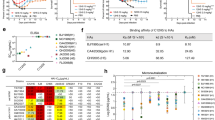Abstract
Influenza virus remains a serious health threat, owing to its ability to evade immune surveillance through rapid genetic drift and reassortment. Here we used a human non-immune antibody phage-display library and the H5 hemagglutinin ectodomain to select ten neutralizing antibodies (nAbs) that were effective against all group 1 influenza viruses tested, including H5N1 'bird flu' and the H1N1 'Spanish flu'. The crystal structure of one such nAb bound to H5 shows that it blocks infection by inserting its heavy chain into a conserved pocket in the stem region, thus preventing membrane fusion. Nine of the nAbs employ the germline gene VH1-69, and all seem to use the same neutralizing mechanism. Our data further suggest that this region is recalcitrant to neutralization escape and that nAb-based immunotherapy is a promising strategy for broad-spectrum protection against seasonal and pandemic influenza viruses.
This is a preview of subscription content, access via your institution
Access options
Subscribe to this journal
Receive 12 print issues and online access
$259.00 per year
only $21.58 per issue
Buy this article
- Purchase on SpringerLink
- Instant access to full article PDF
Prices may be subject to local taxes which are calculated during checkout







Similar content being viewed by others
References
WHO. Factsheet 211: influenza. World Health Organization 〈http://www.who.int/mediacentre/factsheets/2003/fs211/en/〉 (2003).
Webster, R.G. 1918 Spanish influenza: the secrets remain elusive. Proc. Natl. Acad. Sci. USA 96, 1164–1166 (1999).
de Wit, E. & Fouchier, R.A. Emerging influenza. J. Clin. Virol. 41, 1–6 (2008).
WHO. Global influenza surveillance. World Health Organization 〈http://www.who.int/csr/disease/influenza/influenzanetwork/en/index.html〉 (2008).
Carrat, F. & Flahault, A. Influenza vaccine: the challenge of antigenic drift. Vaccine 25, 6852–6862 (2007).
Cinatl, J. Jr, Michaelis, M. & Doerr, H.W. The threat of avian influenza A (H5N1). Part IV: development of vaccines. Med. Microbiol. Immunol. 196, 213–225 (2007).
Subbarao, K. & Luke, C. H5N1 viruses and vaccines. PLoS Pathog. 3, e40 (2007).
Leroux-Roels, I. et al. Broad clade 2 cross-reactive immunity induced by an adjuvanted clade 1 rH5N1 pandemic influenza vaccine. PLoS ONE 3, e1665 (2008).
Baras, B. et al. Cross-Protection against lethal H5N1 challenge in ferrets with an adjuvanted pandemic influenza vaccine. PLoS ONE 3, e1401 (2008).
de Jong, M.D. et al. Oseltamivir resistance during treatment of influenza A (H5N1) infection. N. Engl. J. Med. 353, 2667–2672 (2005).
WHO. Clinical management of human infection with avian influenza A (H5N1) virus. World Health Organization 〈http://www.who.int/csr/disease/avian_influenza/ guidelines/ClinicalManagement07.pdf〉 (2007).
Wright, P., Neumann, G. & Kawaoka, Y. Orthomyxoviruses. in Fields Virology Vol. 2 (eds. Knipe, D., Howley, P., Griffin, D., Lamb, R. & Martin, M.) 1692–1740 (Lippincott Williams & Wilkins, Philadelphia, PA, 2006).
Fauci, A.S. Pandemic influenza threat and preparedness. Emerg. Infect. Dis. 12, 73–77 (2006).
Marasco, W.A. & Sui, J. The growth and potential of human antiviral monoclonal antibody therapeutics. Nat. Biotechnol. 25, 1421–1434 (2007).
WHO. Antigenic and genetic characteristics of H5N1 viruses and candidate H5N1 vaccine viruses developed for potential use as pre-pandemic vaccines. World Health Organization 〈http://www.who.int/csr/disease/avian_influenza/guidelines/ summaryH520070403.pdf〉 (2007).
World Health Organization Global Influenza Program Surveillance Network. Evolution of H5N1 avian influenza viruses in Asia. Emerg. Infect. Dis. 11, 1515–1521 (2005).
Stevens, J. et al. Structure and receptor specificity of the hemagglutinin from an H5N1 influenza virus. Science 312, 404–410 (2006).
Sui, J. et al. Potent neutralization of severe acute respiratory syndrome (SARS) coronavirus by a human mAb to S1 protein that blocks receptor association. Proc. Natl. Acad. Sci. USA 101, 2536–2541 (2004).
Skehel, J.J. & Wiley, D.C. Receptor binding and membrane fusion in virus entry: the influenza hemagglutinin. Annu. Rev. Biochem. 69, 531–569 (2000).
Kida, H., Yoden, S., Kuwabara, M. & Yanagawa, R. Interference with a conformational change in the haemagglutinin molecule of influenza virus by antibodies as a possible neutralization mechanism. Vaccine 3, 219–222 (1985).
Ha, Y., Stevens, D.J., Skehel, J.J. & Wiley, D.C. H5 avian and H9 swine influenza virus haemagglutinin structures: possible origin of influenza subtypes. EMBO J. 21, 865–875 (2002).
Chothia, C. et al. Structural repertoire of the human VH segments. J. Mol. Biol. 227, 799–817 (1992).
Samanta, U., Pal, D. & Chakrabarti, P. Packing of aromatic rings against tryptophan residues in proteins. Acta Crystallogr. D Biol. Crystallogr. 55, 1421–1427 (1999).
Weis, W.I., Brunger, A.T., Skehel, J.J. & Wiley, D.C. Refinement of the influenza virus hemagglutinin by simulated annealing. J. Mol. Biol. 212, 737–761 (1990).
Pal, D. & Chakrabarti, P. Non-hydrogen bond interactions involving the methionine sulfur atom. J. Biomol. Struct. Dyn. 19, 115–128 (2001).
Champ, P.C. & Camacho, C.J. FastContact: a free energy scoring tool for protein-protein complex structures. Nucleic Acids Res. 35, W556–W560 (2007).
Stevens, J. et al. Structure of the uncleaved human H1 hemagglutinin from the extinct 1918 influenza virus. Science 303, 1866–1870 (2004).
Daniels, R.S. et al. Fusion mutants of the influenza virus hemagglutinin glycoprotein. Cell 40, 431–439 (1985).
Thoennes, S. et al. Analysis of residues near the fusion peptide in the influenza hemagglutinin structure for roles in triggering membrane fusion. Virology 370, 403–414 (2008).
Earp, L.J., Delos, S.E., Park, H.E. & White, J.M. The many mechanisms of viral membrane fusion proteins. Curr. Top. Microbiol. Immunol. 285, 25–66 (2005).
Barbey-Martin, C. et al. An antibody that prevents the hemagglutinin low pH fusogenic transition. Virology 294, 70–74 (2002).
Russell, R.J. et al. H1 and H7 influenza haemagglutinin structures extend a structural classification of haemagglutinin subtypes. Virology 325, 287–296 (2004).
Fouchier, R.A. et al. Characterization of a novel influenza A virus hemagglutinin subtype (H16) obtained from black-headed gulls. J. Virol. 79, 2814–2822 (2005).
Gamblin, S.J. et al. The structure and receptor binding properties of the 1918 influenza hemagglutinin. Science 303, 1838–1842 (2004).
Yamada, S. et al. Haemagglutinin mutations responsible for the binding of H5N1 influenza A viruses to human-type receptors. Nature 444, 378–382 (2006).
Ha, Y., Stevens, D.J., Skehel, J.J. & Wiley, D.C. X-ray structure of the hemagglutinin of a potential H3 avian progenitor of the 1968 Hong Kong pandemic influenza virus. Virology 309, 209–218 (2003).
Chen, J., Skehel, J.J. & Wiley, D.C. N- and C-terminal residues combine in the fusion-pH influenza hemagglutinin HA2 subunit to form an N cap that terminates the triple-stranded coiled coil. Proc. Natl. Acad. Sci. USA 96, 8967–8972 (1999).
Sui, J. et al. Broadening of neutralization activity to directly block a dominant antibody-driven SARS-coronavirus evolution pathway. PLoS Pathog. 4, e1000197 (2008).
Okuno, Y., Isegawa, Y., Sasao, F. & Ueda, S. A common neutralizing epitope conserved between the hemagglutinins of influenza A virus H1 and H2 strains. J. Virol. 67, 2552–2558 (1993).
Smirnov, Y.A. et al. An epitope shared by the hemagglutinins of H1, H2, H5, and H6 subtypes of influenza A virus. Acta Virol. 43, 237–244 (1999).
Smirnov, Y.A., Lipatov, A.S., Gitelman, A.K., Claas, E.C. & Osterhaus, A.D. Prevention and treatment of bronchopneumonia in mice caused by mouse-adapted variant of avian H5N2 influenza A virus using monoclonal antibody against conserved epitope in the HA stem region. Arch. Virol. 145, 1733–1741 (2000).
Lim, A.P. et al. Neutralizing human monoclonal antibody against H5N1 influenza HA selected from a Fab-phage display library. Virol. J. 5, 130 (2008).
Huang, C.C. et al. Structural basis of tyrosine sulfation and VH-gene usage in antibodies that recognize the HIV type 1 coreceptor-binding site on gp120. Proc. Natl. Acad. Sci. USA 101, 2706–2711 (2004).
Luftig, M.A. et al. Structural basis for HIV-1 neutralization by a gp41 fusion intermediate-directed antibody. Nat. Struct. Mol. Biol. 13, 740–747 (2006).
Chan, C.H., Hadlock, K.G., Foung, S.K. & Levy, S. V H 1–69 gene is preferentially used by hepatitis C virus-associated B cell lymphomas and by normal B cells responding to the E2 viral antigen. Blood 97, 1023–1026 (2001).
Lee, J.E. et al. Structure of the Ebola virus glycoprotein bound to an antibody from a human survivor. Nature 454, 177–182 (2008).
Kashyap, A.K. et al. Combinatorial antibody libraries from survivors of the Turkish H5N1 avian influenza outbreak reveal virus neutralization strategies. Proc. Natl. Acad. Sci. USA 105, 5986–5991 (2008).
Scherer, E.M., Zwick, M.B., Teyton, L. & Burton, D.R. Difficulties in eliciting broadly neutralizing anti-HIV antibodies are not explained by cardiolipin autoreactivity. AIDS 21, 2131–2139 (2007).
Selvarajah, S. et al. Focused dampening of antibody response to the immunodominant variable loops by engineered soluble gp140. AIDS Res. Hum. Retroviruses 24, 301–314 (2008).
Scheerlinck, J.P. et al. Redistribution of a murine humoral immune response following removal of an immunodominant B cell epitope from a recombinant fusion protein. Mol. Immunol. 30, 733–739 (1993).
Throsby, M. et al. Heterosubtypic neutralizing monoclonal antibodies cross-protective against H5N1 and H1N1 recovered from human IgM+ memory B cells. PLoS ONE 3, e3942 (2008).
Kabsch, W. Automatic processing of rotation diffraction data from crystals of initially unknown symmetry and cell constants. J. Appl. Cryst. 26, 795–800 (1993).
Otwinowski, Z.O. & Minor, W. Processing of X-ray diffraction data collected in oscillation mode. Methods Enzymol. 276, 307–326 (1997).
Hwang, W.C. et al. Structural basis of neutralization by a human anti-severe acute respiratory syndrome spike protein antibody, 80R. J. Biol. Chem. 281, 34610–34616 (2006).
Rodriguez, R., Chinea, G., Lopez, N., Pons, T. & Vriend, G. Homology modeling, model and software evaluation: three related resources. Bioinformatics 14, 523–528 (1998).
Murshudov, G.N., Vagin, A.A. & Dodson, E.J. Refinement of macromolecular structures by the maximum-likelihood method. Acta Crystallogr. D Biol. Crystallogr. 53, 240–255 (1997).
Emsley, P. & Cowtan, K. Coot: model-building tools for molecular graphics. Acta Crystallogr. D Biol. Crystallogr. 60, 2126–2132 (2004).
McRee, D.E. A visual protein crystallographic software system for X11/Xview. J. Mol. Graph. 10, 44–46 (1992).
Laskowski, R.A., MacArthur, M.W., Moss, D.S. & Thornton, J.M. PROCHECK: a program to check the stereochemical quality of protein structures. J. Appl. Cryst. 26, 283–291 (1993).
Rowe, T. et al. Detection of antibody to avian influenza A (H5N1) virus in human serum by using a combination of serologic assays. J. Clin. Microbiol. 37, 937–943 (1999).
Bullough, P.A., Hughson, F.M., Skehel, J.J. & Wiley, D.C. Structure of influenza haemagglutinin at the pH of membrane fusion. Nature 371, 37–43 (1994).
Acknowledgements
We thank J. Appleton (Cornell University) for the gift of mouse mAbs against H5N1, 17A2.1.2 and 22F; A. Klimov (CDC) and A. Balish (CDC) for providing ferret antiserum and virus sequences; R. Webster (St. Jude Children's Research Hospital) for H11N9, H13N6 and H16N3; L. Quynh Mai (National Institute of Hygiene and Epidemiology, Vietnam Ministry of Health) for H5N1; W. Lim (Hong Kong Department of Health) for H5N1 and H9N2, as well as E. Sedyaningsih, T. Soendoro (National Institute of Health Research and Development, Indonesian Ministry of Health) for H5N1 specimens; P. Palese (Mount Sinai School of Medicine) for pCAGGS-H1(SC) plasmid encoding the full-length hemagglutinin protein of H1-SC1918; M. Farzan (New England Primate Research Center, Harvard Medical School) for pCAGGS-H1 (PR) plasmid encoding the hemagglutinin protein of H1-PR34 and X. Yang (Beth Israel Deaconess Medical Center, Harvard Medical School) for pCAGGS-H7 (FPV) encoding H7-FP34 hemagglutinin; and R. Fuller (University of Michigan) for furin cDNA. We thank W. Yuan and W. Li for helpful discussions and Y. Lin for assistance in crystallization and critical discussion. We thank the US National Institutes of Health (NIH) and the Department of Energy (DOE) for access to the Stanford Synchrotron Radiation Facility and the facility staff for assistance in X-ray data collection. Molecular graphics images were produced using the UCSF Chimera package from the Resource for Biocomputing, Visualization, and Informatics at the University of California, San Francisco (supported by NIH P41 RR-01081). This work was supported by NIH (U01-AI074518-01) to W.A.M. and in part by NIH (P01-AI055789) to R.C.L.
Author information
Authors and Affiliations
Contributions
In the DFCI team, J.S. and A.M. constructed H5-TH04 hemagglutinin; J.S. and D.A. performed phage-display antibody library selections and screening for antibodies by ELISA, FACS and pseudovirus-neutralization assays; J.S., M.A. and T.H. carried out epitope mapping using mutagenesis and FACS analysis; J.S., D.A. and M.A. purified antibodies; J.S. and A.Y. analyzed kinetics of antibody binding with hemagglutinin protein; J.S. performed hemagglutinin subtype cross-binding and neutralization assays, pseudovirus binding and fusion inhibition assay; J.S. and W.A.M. designed the study, analyzed data and wrote the sections about these studies. In the BIMR team, R.C.L. supervised all of the work; G.W. and G.C. cloned and expressed recombinant H5 for antibody panning and crystallization. W.C.H. expressed F10 scFv and crystallized the F10–HA0 complex; W.C.H., E.S. and B.S. collected diffraction data and solved and refined the structure; L.A.B. supervised cloning and expression; W.C.H., L.A.B. and R.C.L. wrote sections about these studies. In the CDC team, S.P., L.C., H.W., N.J.C. and R.O.D. designed the study and performed animal studies as well as virology studies with wild-type viruses; R.O.D wrote sections of these studies; J.S., R.O.D., R.C.L. and W.A.M. finalized the paper. All authors commented on the manuscript.
The findings and conclusions in this report are those of the authors and do not necessarily represent the views of the Centers for Disease Control and Prevention or the Agency for Toxic Substances and Disease Registry.
Corresponding authors
Supplementary information
Supplementary Text and Figures
Supplementary Figures 1–9, Supplementary Tables 1–3, Supplementary Notes 1–6 and Supplementary Methods (PDF 847 kb)
Rights and permissions
About this article
Cite this article
Sui, J., Hwang, W., Perez, S. et al. Structural and functional bases for broad-spectrum neutralization of avian and human influenza A viruses. Nat Struct Mol Biol 16, 265–273 (2009). https://doi.org/10.1038/nsmb.1566
Received:
Accepted:
Published:
Issue date:
DOI: https://doi.org/10.1038/nsmb.1566
This article is cited by
-
The generation of hemagglutinin monoclonal antibodies against H9N2 influenza virus
Animal Diseases (2023)
-
Structural insights into the broad protection against H1 influenza viruses by a computationally optimized hemagglutinin vaccine
Communications Biology (2023)
-
Structural characterisation of hemagglutinin from seven Influenza A H1N1 strains reveal diversity in the C05 antibody recognition site
Scientific Reports (2023)
-
Genetic variation in the immunoglobulin heavy chain locus shapes the human antibody repertoire
Nature Communications (2023)
-
A chimeric thermostable M2e and H3 stalk-based universal influenza A virus vaccine
npj Vaccines (2022)



